measuring scales in research methodology
Measuring scales
In this tutorial, we will discuss measuring scales in research.
| ✰ According to Stevens, measurement scales can be of four types and they are listed below. |
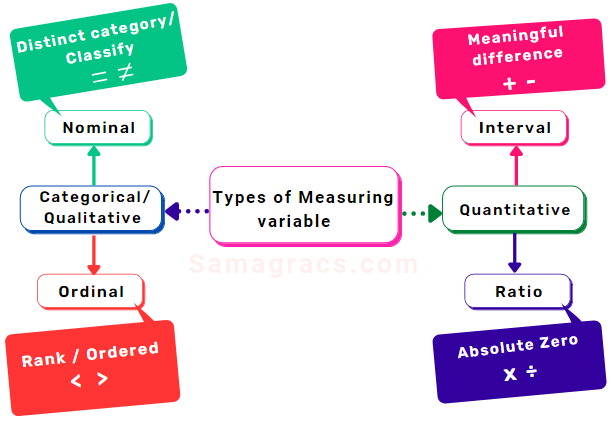
1) Nominal scale:
1) Nominal scale:
| ✰ A nominal scale is simply a system of assigning number symbols to events order to label them. ✰ A variable measured on a nominal scale may have one, two, or more subcategories depending upon the extent of variation. ✰ The usual example of a Nominal scale is the assignment of numbers of cricket players in order to identify them. These numbers are just convenient ways of keeping track of each player on the cricket team. ✰ The nominal scale is the least powerful level of measurement. It indicates no order or distance relationship and has no arithmetic origin. A nominal scale simply describes differences between things by assigning them to categories or numbers. |
Examples of nominal scale:
1.
2.
3.
| ✰ Therefore, the nominal scale offers a label. |
2) Ordinal Scale:
2) Ordinal Scale:
| ✰ An ordinal scale has all the characteristics of a nominal scale. ✰ It usually ranks the subgroups in a certain sequence or order. ✰ The ordinal scale places events in order, but there is no attempt to make the intervals of the scale equal in terms of some rule. ✰ A student’s rank in his graduation class involves the use of an ordinal scale. ✰ Ordinal scales only permit the ranking of items from highest to lowest. Ordinal measures have no absolute values, and the real differences between adjacent ranks may not be equal. ✰ The use of an ordinal scale implies a statement of ‘greater than’ or ‘less than’ (an equality statement is also acceptable) without our being able to state how much greater or less. The real difference between ranks 1 and 2 may be more or less than the difference between ranks 5 and 6. |
Examples of ordinal scale:
Examples of ordinal scale:
1.
2.
| ✰ Therefore, the ordinal scale offers label, order. |
3) Interval scale:
| ✰ An interval scale has all the characteristics of an ordinal scale, In addition to it, it uses a unit of measurement with arbitrary starting and terminating points. ✰ It provide more powerful measurement than ordinal scales for interval scale also incorporates the concept of equality of interval. ✰ Interval scales can have an arbitrary zero. ✰ The primary limitation of the interval scale is the lack of a true zero; it does not have the capacity to measure the complete absence of a trait or characteristic. |
Examples of Interval scale:
Examples of Interval scale:
1. 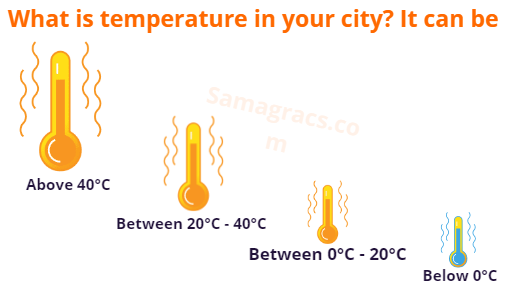
2. 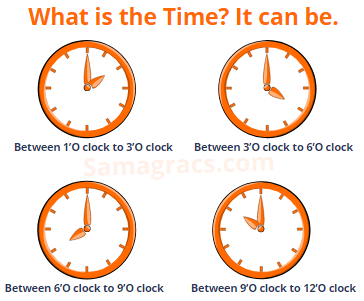
| ✰ Therefore, the interval scale offers label, order and a specific interval between adjacent points. |
4) Ratio scale:
| ✰ An interval scale has all the characteristics of an ordinal scale, In addition to it, it consists of equidistant points and has a meaningful zero point and It has a fixed starting point. ✰ Ratio scales have an absolute or true zero of measurement. For example, the zero point on a centimeter scale indicates the complete absence of length or height. ✰ Measures of physical dimensions such as weight, height, distance, etc. are examples of a ratio scale. ✰ Multiplication and division can be used with this scale but not with other scales discussed above. ✰ Therefore, the ratio scale offers label, order, a specific equal interval between adjacent points as well as absolute or true. |
Examples of ratio scale:
1. 
2.
| ✰ Therefore, the ratio scale offers label, order, a specific equal interval between adjacent points as well as absolute or true. |
Scales of measurement
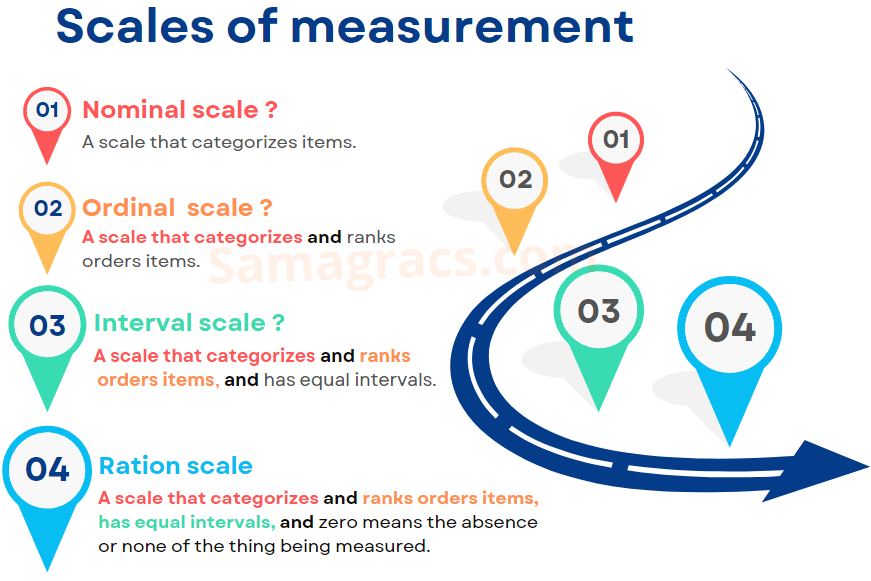
Difference between scales, nominal, ordinal, interval and ratio:
Difference between scales, nominal, ordinal, interval and ratio:
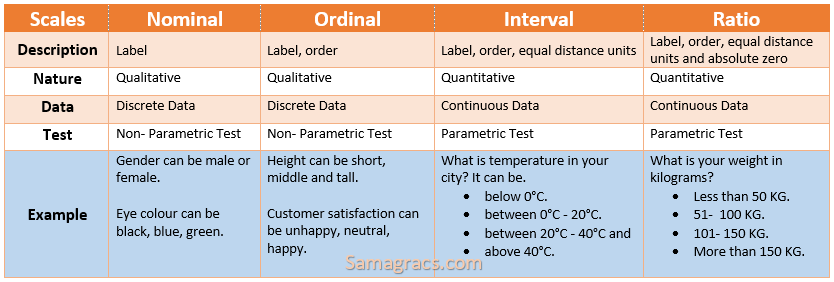
You Should Learn Attitudinal scale for Better Performance
You should learn previous year solution on this topic. GO Below ☟
| Research Content : |
- Introduction of Research
- Objective of Research
- Desirable Motivation
- Characteristics of research
- Positivism or postpositivism
- Classification of research
- Fundamental research
- Applied research
- Difference between fundamental and applied research
- Quantitative research
- Qualitative research
- Descriptive research
- Correlational research
- Exploratory research
- Explanatory research
- Experimental Research
- True experimental VS Quasi-experimental
- Inductive Research
- Deductive Research
- Inductive Research VS Deductive Research
- Conceptual Research
- Empirical Research
- Conceptual Research VS Empirical Research
- Structured Research
- Unstructured Research
- Ex-post facto Research
- Historical Research
- Analytical research
measuring scales in research methodology
